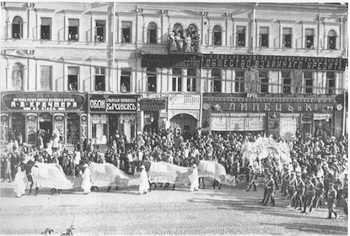

|
Stolypin's Fall  Stolypin's funeral, St Petersburg, 1911 Increasingly abandoned by the gentry, Stolypin became more reliant on the Nationalists, formed in 1909 to represent the interests of the Russians in the empire's Polish borderlands. The zemstvos had never been established in these Western districts, since most of the landowners were Poles. But the Nationalists campaigned for a Western Zemstvo Bill, arguing that Russia's imperial interests could be secured by a complex voting procedure based on nationality as well as property. The bill was passed by the Duma but defeated in the State Council, where the gentry's fundamentalists were unwilling to see the privileges of the noble estate sacrificed to ensure the domination of Russian interests; the fact that the Poles were aristocrats should in their view take precedence over the fact that the peasants were Russians. Stolypin threatened to resign unless the Tsar prorogued the Duma and passed the bill by emergency decree under Article 87. Reluctantly, the Tsar agreed. Stolypin had prevailed by sheer force of character. But his high-handed tactics had alienated almost everyone. The Tsar had been humiliated, and it was now far from clear whether the Prime Minister could count on his support. On 1 September 1911 Stolypin was assassinated by a student-revolutionary turned police informer called D.G. Bogrov in the Kiev Opera house. On hearing of his death, the Tsar was heard to say: 'Now there will be no more talk about reform'. Some historians speculate that the assassination was approved or even organized by police agents with connections to the court. |
© 2014 Orlando Figes | All Rights Reserved